Can You Travel To Cuba From Mexico? Absolutely! It’s a popular and often simpler route for travelers, particularly Americans. TRAVELS.EDU.VN is here to guide you through the ins and outs of planning your Cuban adventure via Mexico, ensuring a smooth and unforgettable experience. We will provide detailed insights on visa requirements, flight options, and money matters, and navigating Cuban culture.
- Cuba Travel Restrictions: OFAC, General License, Support for the Cuban People
- Flights to Cuba: Visa, Cuban Tourist Card
1. Can Americans Travel to Cuba from Mexico?
Yes, Americans can travel to Cuba from Mexico. In fact, it’s a very common route. Flying through Mexico is often a more straightforward process for Americans, as it avoids some of the direct travel restrictions. However, understanding the requirements is key.
Many Americans opt to fly to Cuba from Mexico because it can sometimes be less complicated than flying directly from the United States. Plus, it offers an opportunity to explore Mexico as well. Remember, U.S. regulations require that your Cuban travel fall under one of 12 authorized categories. According to a 2023 report by the U.S. Department of Treasury, enforcement of these regulations has increased, so it’s important to be compliant.
1.1 What are the authorized categories for U.S. citizens traveling to Cuba?
The U.S. government requires that travel to Cuba falls within one of 12 authorized categories. These categories are defined by the Office of Foreign Assets Control (OFAC). They include:
- Family visits
- Official business of the U.S. government, foreign governments, and certain intergovernmental organizations
- Journalistic activity
- Professional research and professional meetings
- Educational activities
- Religious activities
- Public performances, clinics, workshops, athletic and other competitions, and exhibitions
- Support for the Cuban people
- Humanitarian projects
- Activities of private foundations or research or educational institutes
- Exportation, importation, or transmission of information or informational materials
- Certain export transactions
1.2 How does flying from Mexico affect these requirements?
Flying from Mexico does not exempt U.S. citizens from needing to comply with these requirements. You’ll still need to ensure your trip fits into one of the 12 authorized categories. The most common category used by tourists is “Support for the Cuban People,” which requires engaging in activities that directly benefit Cuban citizens.
1.3 What does “Support for the Cuban People” mean practically?
“Support for the Cuban People” means your trip should involve activities that directly benefit the Cuban people. This might include staying in casas particulares (private homestays), eating at privately-owned restaurants (paladares), taking tours with local guides, and purchasing goods and services from local entrepreneurs. Avoid patronizing businesses that are owned or controlled by the Cuban government.
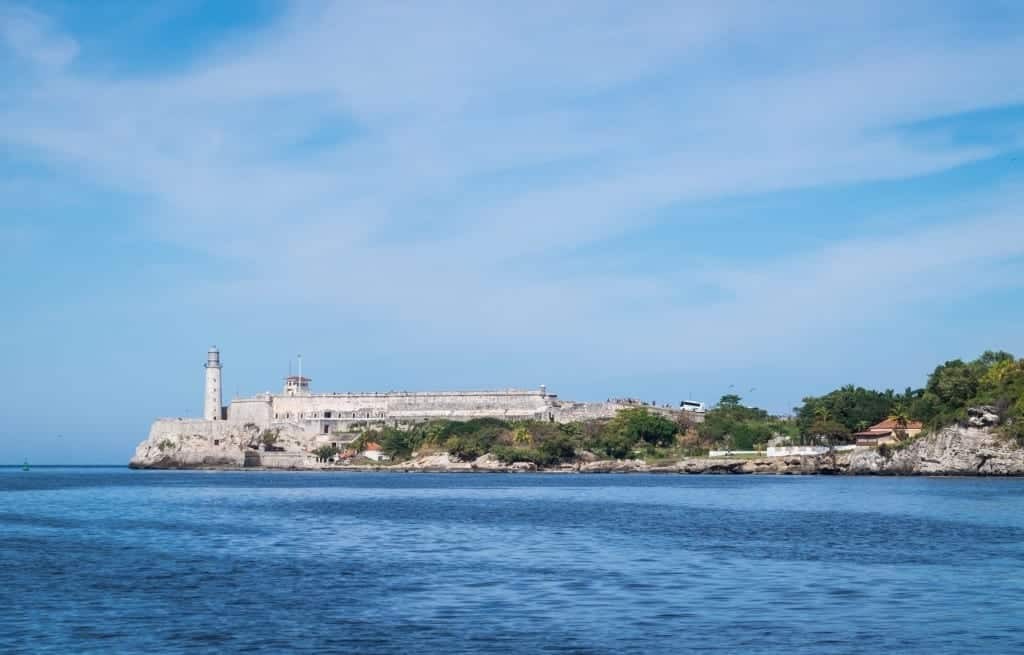 Havana from the Malecon
Havana from the Malecon
1.4 What documentation do I need to prove I’m supporting the Cuban people?
It’s a good idea to keep a record of your activities in Cuba. This could include receipts from casas particulares and paladares, documentation of tours with local guides, and records of any goods purchased from local vendors. While it’s unlikely you’ll be asked for this documentation, it’s best to be prepared.
1.5 Can TRAVELS.EDU.VN help me plan a trip that meets these requirements?
Absolutely! TRAVELS.EDU.VN specializes in crafting itineraries that comply with U.S. regulations and provide meaningful experiences that support the Cuban people. Contact us at +1 (707) 257-5400 or visit our website, TRAVELS.EDU.VN, to learn more. Our office is located at 123 Main St, Napa, CA 94559, United States.
2. What Visa Do You Need to Travel to Cuba from Mexico?
When traveling to Cuba from Mexico, you’ll need a Cuban Tourist Card (also known as a Cuban visa). This card is different from the visa you’d need if flying directly from the U.S.
According to the Cuban government, all visitors must have a valid passport and a tourist card to enter the country. A tourist card is valid for a single entry and allows you to stay in Cuba for up to 30 days.
2.1 What is a Cuban Tourist Card?
A Cuban Tourist Card is essentially a visa that allows you entry into Cuba for tourism purposes. It’s valid for 30 days and can be extended once for an additional 30 days while in Cuba.
2.2 How do I obtain a Cuban Tourist Card in Mexico?
The easiest way to get a Cuban Tourist Card when traveling from Mexico is to purchase it at the airport before your flight. Airlines like Aeromexico and Interjet usually have kiosks or desks where you can buy the card. In Cancún, for example, Interjet sells the tourist cards near the check-in area for Havana flights.
2.3 What is the cost of a Cuban Tourist Card in Mexico?
The cost typically ranges from $20 to $30 USD, but this can vary depending on the airline and the airport. It’s best to have cash on hand in either U.S. dollars or Mexican pesos.
2.4 Is the Tourist Card different depending on where I fly from?
Yes. There are two types of Cuban Tourist Cards:
- Green Tourist Card: Used for those flying from any country other than the United States.
- Pink Tourist Card: Used for those flying directly from the United States.
Since you’re traveling from Mexico, you’ll need the green tourist card.
2.5 Can I purchase the Tourist Card in advance?
While it’s generally easy to buy the tourist card at the airport, you can purchase it in advance from online vendors if you prefer. However, this usually involves additional processing fees and isn’t necessary for most travelers.
2.6 What happens if I arrive in Cuba without a Tourist Card?
You will likely be denied entry into Cuba. It’s essential to obtain the Tourist Card before boarding your flight to avoid any issues.
2.7 What are the key differences between a Cuban Tourist Card obtained in Mexico versus a U.S. visa?
The Cuban Tourist Card, obtained when flying from Mexico, is different from the visa required for direct travel from the U.S. Here’s a breakdown of the key differences:
| Feature | Cuban Tourist Card (Flying from Mexico) | U.S. Visa (Flying from the U.S.) |
|---|---|---|
| Purpose | Tourism | Specific authorized category |
| Validity | 30 days, single entry | Varies based on category |
| Obtaining | Airport in Mexico | Application through airline/agency |
| Cost | $20 – $30 USD | Varies |
| Compliance | Passport and Tourist Card | Adherence to OFAC regulations |
TRAVELS.EDU.VN can help you navigate these requirements, ensuring a smooth and compliant trip. Contact us today for personalized assistance!
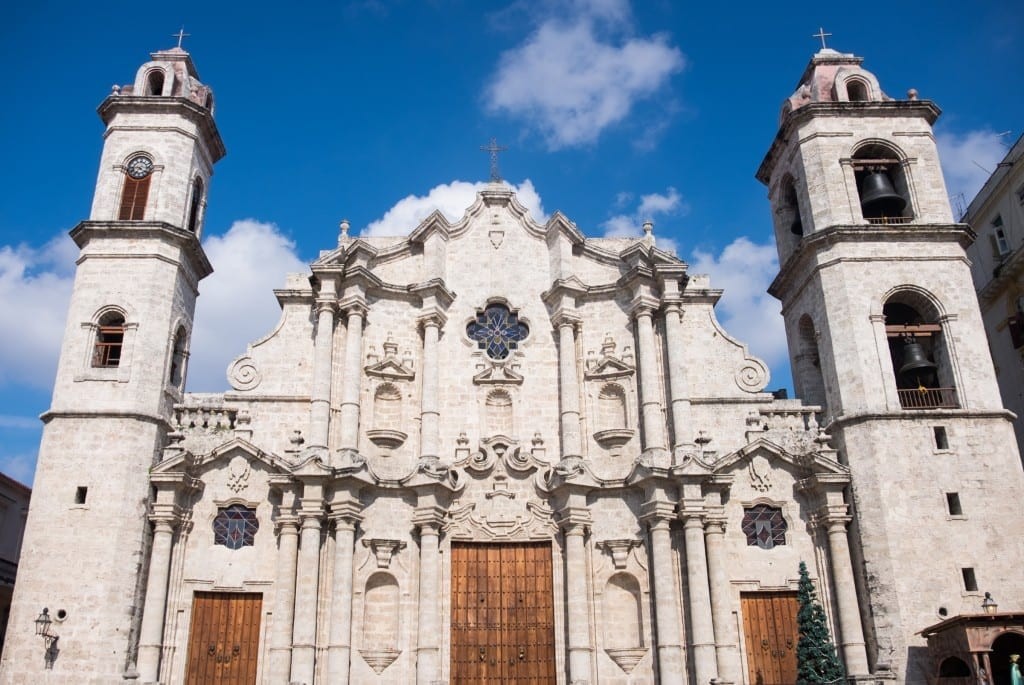 A church in Old Havana
A church in Old Havana
3. What are the Best Flight Options from Mexico to Cuba?
Several airlines offer flights from various cities in Mexico to Cuba. The most popular routes are from Cancún and Mexico City to Havana.
According to data from Skyscanner, the most popular airlines for flights from Mexico to Cuba include Aeromexico, Copa Airlines, and VivaAerobus. Flight prices can vary widely depending on the season and how far in advance you book.
3.1 Which airlines fly from Mexico to Cuba?
- Aeromexico
- Copa Airlines
- VivaAerobus
- Interjet (though its availability may vary)
3.2 Which Mexican cities offer direct flights to Cuba?
- Cancún
- Mexico City
- Mérida
- Monterrey
3.3 What is the average flight time from Mexico to Cuba?
- Cancún to Havana: Approximately 1 hour 15 minutes
- Mexico City to Havana: Approximately 3 hours
3.4 How much does a flight from Mexico to Cuba typically cost?
The cost can vary greatly depending on the time of year and how far in advance you book. Generally, you can expect to pay between $200 and $500 USD for a round-trip flight.
3.5 What is the best time to book flights for the cheapest fares?
According to a study by CheapAir.com, the best time to book international flights is typically 1 to 3 months in advance. However, it’s always a good idea to monitor prices and be flexible with your travel dates.
3.6 Are there any tips for finding cheaper flights?
- Be flexible with your travel dates.
- Book in advance (1-3 months).
- Consider flying mid-week, as these flights are often cheaper.
- Use flight comparison websites like Skyscanner, Google Flights, and Kayak.
- Sign up for fare alerts to be notified of price drops.
3.7 Can TRAVELS.EDU.VN assist with booking flights?
While we don’t directly book flights, TRAVELS.EDU.VN can provide guidance on the best flight options and times to travel based on your needs. Plus, we can coordinate your flights with your overall itinerary for a seamless travel experience. Reach out to us at +1 (707) 257-5400 or visit our website.
4. What About Money? Currency, ATMs, and Credit Cards in Cuba
One of the most important things to know before traveling to Cuba is that U.S.-issued credit and debit cards do not work there. This means you’ll need to bring all the cash you’ll need for your trip.
As of 2024, the Cuban economy is still primarily cash-based. It’s essential to plan accordingly and understand the best ways to manage your money while you’re there. According to the Central Bank of Cuba, the official exchange rate is subject to change, so staying updated is crucial.
4.1 What currency is used in Cuba?
Cuba has two official currencies:
- Cuban Convertible Peso (CUC): Primarily used by tourists.
- Cuban National Peso (CUP): Primarily used by locals.
However, CUC is being phased out, and CUP is becoming more widely used, even by tourists.
4.2 Can I exchange U.S. dollars for Cuban currency?
Yes, you can exchange U.S. dollars for CUP at banks, hotels, and official exchange houses (CADECA) in Cuba. However, be aware that exchange rates can vary, and it’s often more favorable to exchange Euros or Canadian dollars.
4.3 Are there any penalties for exchanging U.S. dollars?
In the past, there was a 10% penalty for exchanging U.S. dollars. As of 2024, this penalty has been lifted, making it more straightforward to use USD.
4.4 Can I use ATMs in Cuba?
No, U.S.-issued debit and credit cards do not work in Cuban ATMs. You must bring enough cash to cover your entire trip.
4.5 Can I use credit cards in Cuba?
No, U.S.-issued credit cards are not accepted in Cuba. Even if you have a visa, your cards will not work.
4.6 How much cash should I bring?
This depends on your travel style and length of stay. As a general guideline, budget around $50-$100 USD per day. This should cover accommodation, food, transportation, and activities.
4.7 Are there any tips for keeping my money safe in Cuba?
- Use a travelsafe to store your valuables in your accommodation.
- Carry a Speakeasy Travel Supply scarf with a hidden pocket to conceal cash.
- Split your cash into different hiding spots in your luggage.
- Be discreet when handling money in public.
4.8 What happens if I run out of money in Cuba?
Running out of money can be a serious issue since you can’t rely on ATMs or credit cards. It’s essential to over-budget and have a contingency plan, such as having a friend or family member who can wire you money through an agency like Western Union (though this can be complicated).
4.9 How can TRAVELS.EDU.VN help me with money management in Cuba?
TRAVELS.EDU.VN provides comprehensive advice on budgeting and managing your finances in Cuba. We can offer tailored recommendations based on your itinerary and travel style to ensure you’re well-prepared. Contact us at +1 (707) 257-5400 for expert guidance.
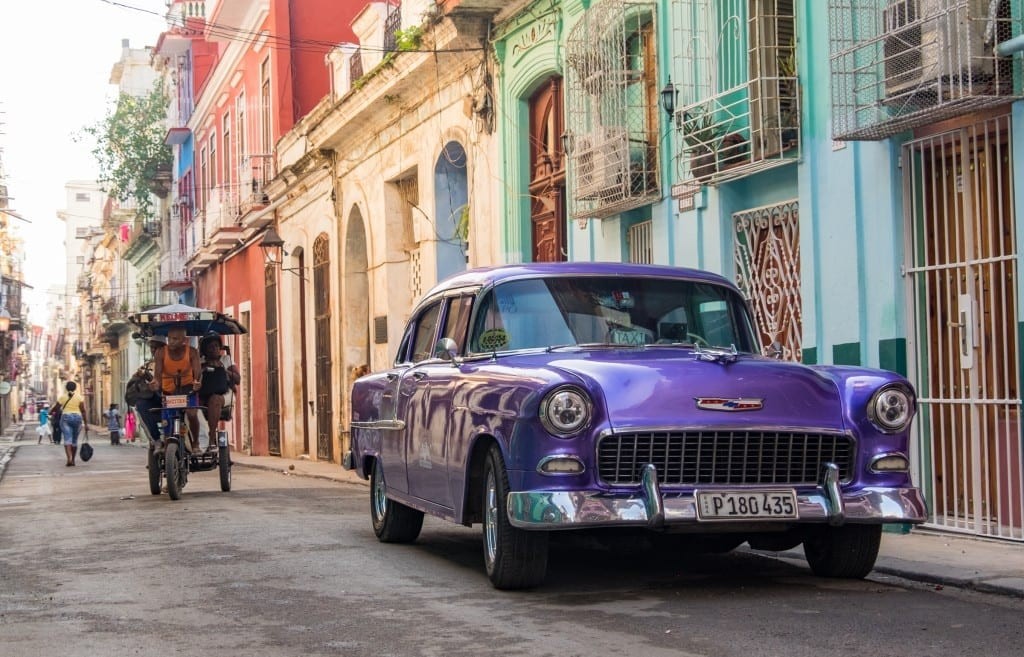 Shiny purple classic car on a brightly colored Havana street
Shiny purple classic car on a brightly colored Havana street
5. Where to Stay: Hotels vs. Casas Particulares
When planning your trip to Cuba, you’ll have two main accommodation options: hotels and casas particulares (private homestays). Each offers a unique experience with its own set of pros and cons.
According to a 2023 report by the Cuba Travel Network, casas particulares are becoming increasingly popular among tourists seeking an authentic cultural experience. These homestays offer a more intimate and immersive way to experience Cuban life.
5.1 What are Casas Particulares?
Casas particulares are private homes or apartments that Cubans rent out to visitors. They are a great way to support the local economy and experience Cuban culture firsthand.
5.2 What are the benefits of staying in a Casa Particular?
- Affordability: Casas particulares are often cheaper than hotels.
- Authenticity: You’ll get to live with a Cuban family and experience their way of life.
- Local Knowledge: Your hosts can provide valuable insights and recommendations.
- Support the Local Economy: Your money goes directly to Cuban families.
5.3 What are the drawbacks of staying in a Casa Particular?
- Limited Amenities: Casas particulares may not offer the same amenities as hotels.
- Language Barrier: Communication can be challenging if you don’t speak Spanish.
- Privacy: You’ll be living in someone’s home, so privacy may be limited.
5.4 What are hotels like in Cuba?
Hotels in Cuba range from budget-friendly options to luxurious resorts. Many are government-owned, so staying in a hotel may not directly support the Cuban people.
5.5 What are the benefits of staying in a hotel?
- Amenities: Hotels typically offer a wider range of amenities, such as swimming pools, restaurants, and Wi-Fi.
- Convenience: Hotels often have English-speaking staff and can assist with booking tours and transportation.
- Privacy: You’ll have your own private space.
5.6 What are the drawbacks of staying in a hotel?
- Cost: Hotels are generally more expensive than casas particulares.
- Less Authentic: You may not get the same cultural experience as staying in a casa particular.
- Government-Owned: Many hotels are owned by the Cuban government, so your money may not directly benefit the Cuban people.
5.7 How do I book a Casa Particular?
You can find casas particulares on websites like Airbnb. It’s a good idea to read reviews and communicate with the host before booking.
5.8 Can TRAVELS.EDU.VN recommend Casas Particulares or Hotels?
Yes, TRAVELS.EDU.VN has partnerships with a network of trusted casas particulares and hotels throughout Cuba. We can provide recommendations based on your preferences and budget. Contact us at +1 (707) 257-5400 for personalized advice.
6. Staying Connected: Internet and Communication in Cuba
Staying connected in Cuba can be challenging. Internet access is limited and often requires purchasing Wi-Fi cards. Understanding how to navigate the internet and communication landscape is essential for a smooth trip.
According to a 2023 report by Freedom House, Cuba has one of the least free internet environments in the world. Access is restricted, and censorship is common.
6.1 Is there internet access in Cuba?
Yes, but it’s not as readily available as in other countries. You’ll primarily find internet access in hotels, parks, and ETECSA (the state-owned telecommunications company) offices.
6.2 How do I access the internet in Cuba?
You’ll need to purchase a Wi-Fi card from ETECSA or a hotel. These cards typically provide one hour of internet access and cost around $1 USD.
6.3 How do I use a Wi-Fi card?
Go to a Wi-Fi hotspot, connect to the network, and enter the username and password on the card. Be sure to log out when you’re finished to conserve your time.
6.4 Can I use my cell phone in Cuba?
Yes, but it can be expensive. Check with your mobile carrier about international roaming charges. Some carriers offer international plans that include Cuba.
6.5 Are there any apps that work well in Cuba?
- WhatsApp: Useful for messaging and calls when you have Wi-Fi.
- Maps.me: Download offline maps of Cuba for navigation.
- Google Translate: Download the Spanish language pack for offline translation.
6.6 Can I use a VPN in Cuba?
Yes, using a VPN can help you bypass censorship and protect your privacy. However, be aware that VPNs may not always work reliably.
6.7 Are there any restrictions on accessing certain websites or apps?
Yes, some websites and apps may be blocked by the Cuban government. Using a VPN can help you access these sites.
6.8 What about phone calls?
Making international calls from Cuba can be expensive. Consider using internet-based calling apps like WhatsApp or Skype when you have Wi-Fi.
6.9 How can TRAVELS.EDU.VN help me stay connected in Cuba?
TRAVELS.EDU.VN provides detailed guidance on navigating the internet and communication landscape in Cuba. We can offer tips on finding Wi-Fi hotspots, using VPNs, and communicating with loved ones back home. Contact us at +1 (707) 257-5400 for expert advice.
 Mojitos in a bar
Mojitos in a bar
7. What to See and Do in Cuba
Cuba is a country rich in history, culture, and natural beauty. From the vibrant streets of Havana to the serene landscapes of Viñales, there’s something for every traveler.
According to UNESCO, Cuba has nine World Heritage Sites, reflecting its rich cultural and natural heritage. These sites include Old Havana, Trinidad, and the Viñales Valley.
7.1 Havana
Havana, the capital of Cuba, is a city that captivates with its blend of colonial architecture, vintage cars, and lively music scene.
- Old Havana: Explore the historic heart of the city, a UNESCO World Heritage Site.
- Malecón: Stroll along the iconic seawall, especially beautiful at sunset.
- Plaza de la Revolución: Visit the site of political rallies and see the José Martí Memorial.
- Museo de la Revolución: Learn about Cuban history and the revolution.
- Fabrica de Arte Cubano: Experience contemporary Cuban art, music, and dance.
7.2 Viñales Valley
Viñales Valley, located in the Pinar del Río province, is a stunning landscape of tobacco fields, limestone hills (mogotes), and caves.
- Tobacco Farms: Visit a tobacco farm and learn about the process of making Cuban cigars.
- Cueva del Indio: Take a boat ride through an underground river in this cave.
- Mural de la Prehistoria: See a giant colorful mural painted on a mogote.
- Hiking: Explore the valley on foot and enjoy the scenic views.
7.3 Trinidad
Trinidad, another UNESCO World Heritage Site, is a well-preserved colonial town with cobblestone streets and colorful buildings.
- Plaza Mayor: Relax in the main square and admire the colonial architecture.
- Museo Histórico Municipal: Learn about the history of Trinidad.
- Iglesia Parroquial de la Santísima Trinidad: Visit the main church in Trinidad.
- Valle de los Ingenios: Explore the ruins of sugar mills and learn about the sugar industry.
- Playa Ancón: Relax on the beach and swim in the Caribbean Sea.
7.4 Varadero
Varadero is a popular beach resort town known for its white sand beaches and turquoise waters.
- Playa Varadero: Relax on the beach and enjoy water sports.
- Parque Josone: Stroll through this beautiful park with gardens, a lake, and a restaurant.
- Cueva de Ambrosio: Visit this cave with pre-Columbian cave paintings.
7.5 Other Activities
- Take a classic car tour: Explore Havana in a vintage American car.
- Learn to dance salsa: Take a salsa lesson and experience Cuban music and dance.
- Attend a baseball game: Baseball is Cuba’s national sport.
- Visit a cigar factory: See how Cuban cigars are made.
- Attend a cooking class: Learn to prepare traditional Cuban dishes.
7.6 How can TRAVELS.EDU.VN help me plan my activities in Cuba?
TRAVELS.EDU.VN offers curated itineraries and personalized recommendations for activities throughout Cuba. We can arrange tours, cooking classes, dance lessons, and more, ensuring you have an unforgettable experience. Contact us at +1 (707) 257-5400 to start planning your Cuban adventure.
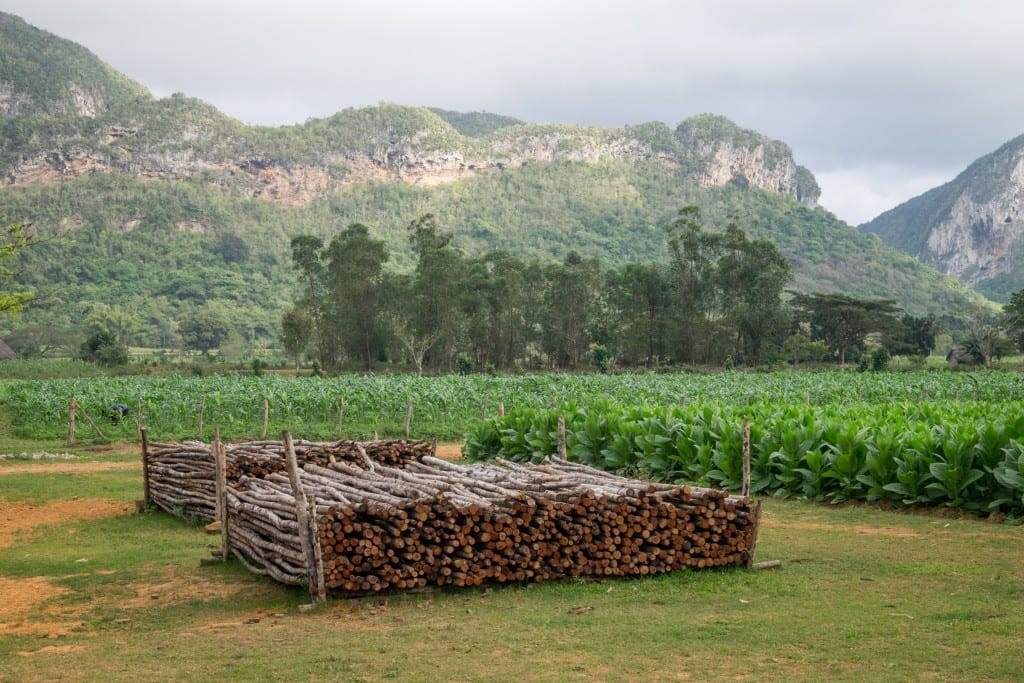 Rows of stacked wood in front of the mountains of Vinales and tobacco fields
Rows of stacked wood in front of the mountains of Vinales and tobacco fields
8. Essential Tips for Traveling to Cuba from Mexico
Traveling to Cuba requires some preparation and awareness of local customs and regulations. Here are some essential tips to ensure a smooth and enjoyable trip.
According to the U.S. Department of State, it’s important to be aware of the restrictions on financial transactions with certain Cuban entities. U.S. citizens are prohibited from engaging in direct financial transactions with entities and subentities identified on the State Department’s Cuba Restricted List.
8.1 Learn Some Spanish
While some Cubans speak English, knowing basic Spanish phrases will greatly enhance your experience.
8.2 Be Prepared for Limited Internet Access
Internet access is limited and can be unreliable. Download offline maps and translation apps before you go.
8.3 Bring Cash
U.S. credit and debit cards do not work in Cuba. Bring enough cash to cover your entire trip.
8.4 Respect Cuban Culture
Be respectful of Cuban customs and traditions. Dress modestly when visiting religious sites.
8.5 Be Aware of U.S. Regulations
U.S. citizens must comply with U.S. regulations regarding travel to Cuba. Ensure your trip falls under one of the 12 authorized categories.
8.6 Stay in Casas Particulares
Staying in casas particulares is a great way to support the local economy and experience Cuban culture.
8.7 Eat at Paladares
Paladares are privately-owned restaurants that offer delicious Cuban cuisine.
8.8 Bargain Respectfully
It’s acceptable to bargain when shopping at markets, but do so respectfully.
8.9 Stay Hydrated
Drink plenty of bottled water to avoid dehydration.
8.10 Pack Appropriately
Pack light, comfortable clothing, sunscreen, insect repellent, and any medications you may need.
8.11 How can TRAVELS.EDU.VN help me prepare for my trip to Cuba?
TRAVELS.EDU.VN offers pre-travel consultations to help you prepare for your trip to Cuba. We can provide detailed information on local customs, U.S. regulations, and essential packing tips. Contact us at +1 (707) 257-5400 for expert guidance.
9. Common Misconceptions About Traveling to Cuba
There are several common misconceptions about traveling to Cuba, particularly for Americans. Clearing up these misconceptions can help you plan a more informed and enjoyable trip.
According to a 2023 survey by the Pew Research Center, many Americans are unaware of the current regulations and restrictions on travel to Cuba. This lack of awareness can lead to confusion and misinformation.
9.1 “It’s illegal for Americans to travel to Cuba.”
This is a common misconception. While there are restrictions, it’s not illegal for Americans to travel to Cuba as long as their trip falls under one of the 12 authorized categories.
9.2 “I need to join a tour group to travel to Cuba legally.”
This is not necessarily true. You can travel independently as long as you comply with U.S. regulations and engage in activities that support the Cuban people.
9.3 “Cuba is dangerous.”
Cuba is generally a safe country for tourists. However, it’s always important to be aware of your surroundings and take precautions against petty theft.
9.4 “I can’t use my cell phone in Cuba.”
You can use your cell phone in Cuba, but it can be expensive. Check with your mobile carrier about international roaming charges.
9.5 “I can’t bring back souvenirs from Cuba.”
You can bring back souvenirs from Cuba, but there are restrictions on certain items, such as Cuban cigars.
9.6 “Cuba is stuck in the 1950s.”
While Cuba is known for its vintage cars and colonial architecture, it’s also a vibrant and modern country with a rich culture and history.
9.7 “Everyone in Cuba is poor and unhappy.”
While Cuba faces economic challenges, the Cuban people are resilient, resourceful, and proud of their culture.
9.8 How can TRAVELS.EDU.VN help me separate fact from fiction about traveling to Cuba?
TRAVELS.EDU.VN provides accurate and up-to-date information about traveling to Cuba. We can help you understand the regulations, dispel common misconceptions, and plan a trip that is both legal and enjoyable. Contact us at +1 (707) 257-5400 for expert advice.
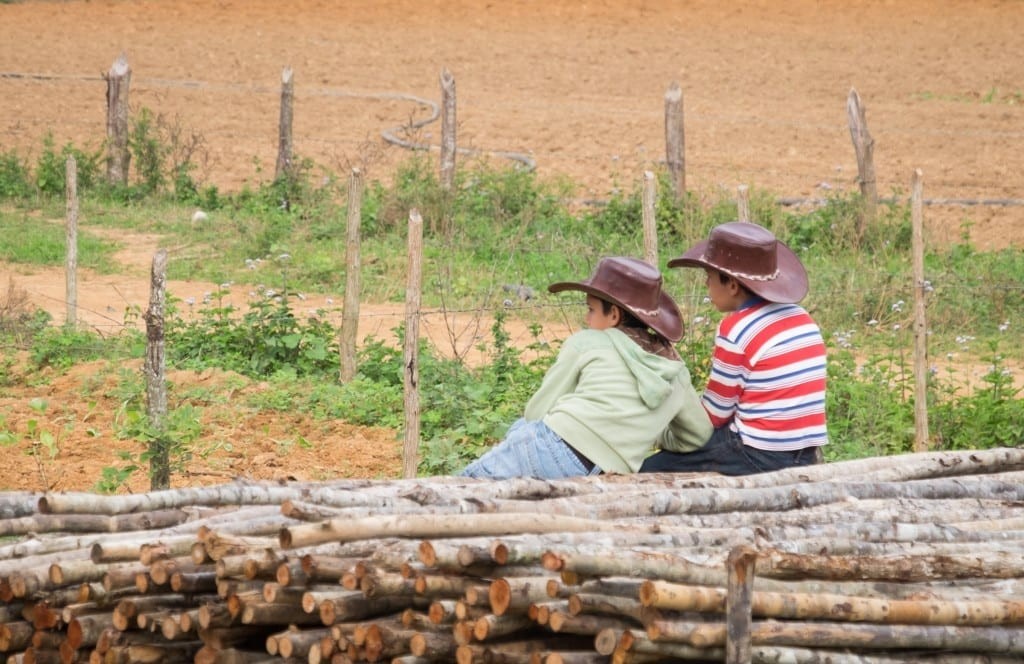 Boys in Vinales
Boys in Vinales
10. FAQs About Traveling to Cuba from Mexico
Here are some frequently asked questions about traveling to Cuba from Mexico to help you plan your trip.
10.1 Do I need a passport to travel to Cuba from Mexico?
Yes, you need a valid passport to travel to Cuba. Make sure your passport is valid for at least six months beyond your intended stay.
10.2 Do I need a visa to travel to Cuba from Mexico?
Yes, you need a Cuban Tourist Card (visa) to travel to Cuba. You can purchase it at the airport in Mexico before your flight.
10.3 Can I fly directly from the U.S. to Cuba?
Yes, there are direct flights from the U.S. to Cuba. However, you must comply with U.S. regulations and ensure your trip falls under one of the 12 authorized categories.
10.4 What currency is used in Cuba?
Cuba uses the Cuban Peso (CUP).
10.5 Can I use U.S. dollars in Cuba?
Yes, you can use U.S. dollars in Cuba.
10.6 Can I use credit cards in Cuba?
No, U.S.-issued credit and debit cards do not work in Cuba. Bring enough cash to cover your entire trip.
10.7 Is it safe to travel to Cuba?
Cuba is generally a safe country for tourists. However, it’s always important to be aware of your surroundings and take precautions against petty theft.
10.8 What should I pack for a trip to Cuba?
Pack light, comfortable clothing, sunscreen, insect repellent, and any medications you may need.
10.9 What are some must-see attractions in Cuba?
Some must-see attractions in Cuba include Old Havana, Viñales Valley, and Trinidad.
10.10 Can TRAVELS.EDU.VN help me plan my trip to Cuba?
Yes, TRAVELS.EDU.VN offers personalized trip planning services for Cuba. We can help you with flights, accommodation, activities, and more. Contact us at +1 (707) 257-5400 to start planning your Cuban adventure.
Ready to experience the allure of Cuba? Let TRAVELS.EDU.VN tailor the perfect itinerary for you. From navigating the regulations to uncovering hidden gems, we’re here to make your journey seamless and unforgettable. Contact us today at 123 Main St, Napa, CA 94559, United States, Whatsapp: +1 (707) 257-5400, or visit our website travels.edu.vn to start planning your Cuban adventure!
